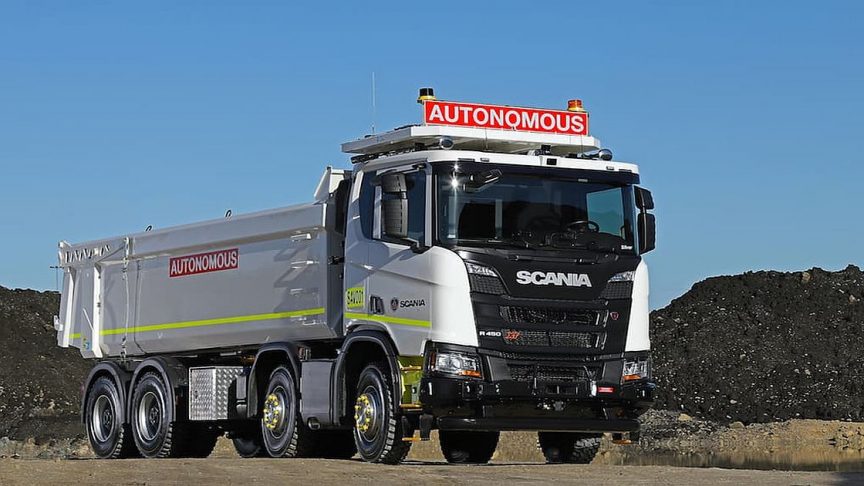Scania Hails Positioning Accuracy Breakthrough for Autonomous Vehicles
Scania said new technology tested in Europe has lead to a breakthrough in safely merging trucks under autonomous control. Autonomous vehicles and advanced driver assistance systems need robust and precise positioning to enable reliable operations. This is especially important in the early transitional phase of the technology, when other vehicles on the road will not be automated.
Swedish truck maker Scania said that working with technology partners in Europe, it has achieved a breakthrough in enhanced positioning accuracy for autonomous vehicles, using the Galileo global navigation satellite system in combination with other positioning and sensor technologies.
This solution was developed as part of Europe’s Propart project – The Precise and Robust Positioning for Automated Road Transports research effort – which involves Scania and six partners.
The Propart technology project combines Real Time Kinematic positioning software from Waysure (Sweden) with satellite measurements from Fraunhofer IIS (Germany). The satellite positioning was augmented with an ultra-wideband ranging solution from Spanish research institution Ceit-IK4.
The company said it believes this technology could eventually become a key enabler for autonomous trucks in the future.
Centimeter-Level Positioning
The project’s vehicle positioning solution was recently demonstrated in a recreated motorway situation at the AstaZero test area in Sweden, with a connected autonomous truck and two unconnected manned cars.
The self-driving truck was supplied by Scania, with Hungary-based vehicle-to-everything communications company Commsignia providing the short-range communication technology. Baselabs from Germany provided sensor data fusion of onboard and roadside sensors and developed a situational assessment for the automated lane change maneuver. The project has received funding from the European GNSS Agency under the European Union’s Horizon 2020 innovation program.
As part of the test, a Scania self-driving truck executed a safe and efficient lane change in traffic. The maneuver was managed by the new system, relying on centimeter-level positioning combined with collaborative perception sensor data.
Scania said the project demonstrated that it was possible to pinpoint the position with 10-centimeter accuracy. The truck could execute the maneuver due to the precise positioning and an accurate representation of the whole surrounding environment. This was achieved by fusing data from the truck’s camera and front and side radars combined with radars mounted on roadside units.
Infrastructure-to-Vehicle Communications
“In addition to positioning, we’ve also added infrastructure-to-vehicle communications,” said Stefan Nord, project coordinator with Rise, a Swedish Research Institute, which coordinated the demonstration.
Ordinarily, Nord added, autonomous vehicles rely on their own sensors to interpret and process data on the surrounding environment. “If vehicles share information, you can extend their horizon and benefit from data from another vehicle to also look around the corner and thereby gather more data as a basis for manoeuvring decisions,” he said.
“In the project, we focused on achieving a positioning error below 20 centimeters in combination with an ambitious target integrity risk – that is, the probability of the position error exceeding this error limit,” explained Fredrik Hoxell, development engineer for Scania Intelligent Transport Systems. “However, for deployment in real-life traffic situations, which tend to be much more dynamic and unstructured, there are of course many more vehicle and system characteristics and possible sources of errors that need to be handled.”
Hoxell noted that Scania is presently investigating several different positioning solutions. “Reliable and high-integrity navigation is absolutely essential when operating autonomous vehicles in uncontrolled environments. These trials offer one possible facet of the overall challenge related to navigation support on the journey towards safe and sustainable autonomous transport,” he said.
The merging demo is featured in this video from Propart partner The Fraunhofer Institute for Integrated Circuits.
by Jack Roberts
Source: https://www.automotive-fleet.com
FLEET MANAGEMENT AUDIT
Fleet management is the use of a set of vehicles in order to provide services to a third-party, or to perform a task for our organization, in the most efficient and productive manner with a determined level of service and cost.
Fleet management activities are shown in the following graph 1:

Graph 1: fleet management activities
The proposal audit analyses and assesses all fleet management activities shown in the graph 1, and its main goals are:
- Know the overall status of the fleet management activities
- Provide the analysis, the assessment, the advice, the suggestions and the actions to take in order to cut costs and increase the efficiency and efficacy of the fleet management activities
With the information obtained, we’ll elaborate a report that holds the overall status of the fleet management as well as the suggestions, recommendations and the measures to take in order to cut costs and optimize the fleet management activities.
CLICK ON THE FOLLOWING LINK TO DOWNLOAD THE PROPOSED FLEET MANAGEMENT AUDIT:



